Fenoldopam
Editor-In-Chief: C. Michael Gibson, M.S., M.D. [1]; Associate Editor(s)-in-Chief: Alonso Alvarado, M.D. [2]; Sheng Shi, M.D. [3]; Ammu Susheela, M.D. [4]
Disclaimer
WikiDoc MAKES NO GUARANTEE OF VALIDITY. WikiDoc is not a professional health care provider, nor is it a suitable replacement for a licensed healthcare provider. WikiDoc is intended to be an educational tool, not a tool for any form of healthcare delivery. The educational content on WikiDoc drug pages is based upon the FDA package insert, National Library of Medicine content and practice guidelines / consensus statements. WikiDoc does not promote the administration of any medication or device that is not consistent with its labeling. Please read our full disclaimer here.
Overview
Fenoldopam is a dopaminergic agonist that is FDA approved for the treatment of severe hypertension when rapid, but quickly reversible, emergency reduction of blood pressure is clinically indicated. Common adverse reactions include hypotension, tachycardia, flushing, nausea, headache.
Adult Indications and Dosage
FDA-Labeled Indications and Dosage (Adult)
- The optimal magnitude and rate of blood pressure reduction in acutely hypertensive patients have not been rigorously determined, but, in general, both delay and too rapid decreases appear undesirable in sick adult patients. An initial fenoldopam dose may be chosen from Tables 2 and 3 below in the Clinical studies section that produces the desired magnitude and rate of blood pressure reduction in a given clinical situation. Doses below 0.1 mcg/kg/min have very modest effects and appear only marginally useful in this population. In general, as the initial dose increases, there is a greater and more rapid blood pressure reduction. However, lower initial doses (0.03 to 0.1 mcg/kg/min) titrated slowly have been associated with less reflex tachycardia than have higher initial doses (≥ 0.3 mcg/kg/min). In clinical trials, doses from 0.01 to 1.6 mcg/kg/min have been studied. Most of the effect of a given infusion rate is attained in 15 minutes.
- Fenoldopam should be administered by continuous intravenous infusion. A bolus dose should not be used. Hypotension and rapid decreases of blood pressure should be avoided. The initial dose should be titrated upward or downward, no more frequently than every 15 minutes (and less frequently as goal pressure is approached) to achieve the desired therapeutic effect. The recommended increments for titration are 0.05 to 0.1 mcg/kg/min.
- Use of a calibrated, mechanical infusion pump is recommended for proper control of infusion rate during fenoldopam infusion. In clinical trials, fenoldopam treatment was safely performed without the need for intra-arterial blood pressure monitoring; blood pressure and heart rate were monitored at frequent intervals, typically every 15 minutes. Frequent blood pressure monitoring is recommended.
- Fenoldopam infusion can be abruptly discontinued or gradually tapered prior to discontinuation. Oral antihypertensive agents can be added during fenoldopam infusion or following its discontinuation. Patients in controlled clinical trials have received intravenous fenoldopam for as long as 48 hours.
Preparation of Infusion Solution
Warning: contents of ampules must be diluted before infusion. Each ampule is for single use only. Dilution:
- The fenoldopam injection ampule concentrate must be diluted in 0.9% Sodium Chloride Injection, USP, or 5% Dextrose Injection, USP, using the following dilution schedule:

- The drug dose rate must be individualized according to body weight and according to the desired rapidity and extent of pharmacodynamic effect. Table 5 provides the calculated infusion volume in mL/hour for a range of drug doses and body weights. The infusion should be administered using a calibrated mechanical infusion pump that can accurately and reliably deliver the desired infusion rate.
Infusion rates:
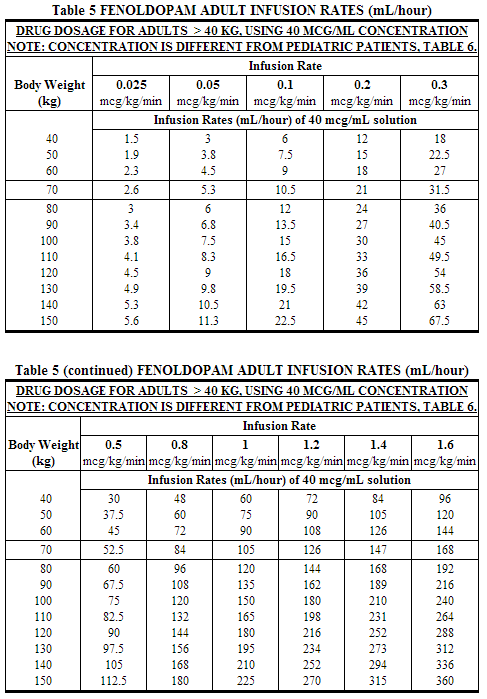
- The diluted solution is stable under normal ambient light and temperature conditions for at least 24 hours. Diluted solution that is not used within 24 hours of preparation should be discarded. Parenteral drug products should be inspected visually for particulate matter and discoloration prior to administration, whenever solution and container permit. If particulate matter or cloudiness is observed, the drug should be discarded.
Off-Label Use and Dosage (Adult)
Guideline-Supported Use
There is limited information regarding Off-Label Guideline-Supported Use of Fenoldopam in adult patients.
Non–Guideline-Supported Use
Acute Renal Failure Prophylaxis-Cardiac Surgery
- Dosing Information
- Infusion of 0.1 mcg/kg/min.[1]
Condition2
- Dosing information
- 0.03 mcg/kg/min infusion administered via central catheter during anesthesia induction. The infusion should be maintained thought all the surgical time and continued until patient stabilization during the postoperative period.[2]
Pediatric Indications and Dosage
FDA-Labeled Indications and Dosage (Pediatric)
- Fenoldopam should be administered intravenously to pediatric patients by a continuous infusion pump appropriate for the delivery of low infusion rates.
- Monitoring of blood pressure should be continuous, usually by way of an intra-arterial line. Heart rate should also be continuously monitored. In the clinical trial, the usual starting dose was 0.2 mcg/kg/min with an effect on MAP evident within 5 minutes. At a constant infusion rate the effect was maximal after 20 to 25 minutes. Increased dosages of up to 0.3 to 0.5 mcg/kg/min every 20 to 30 minutes were generally well tolerated. Tachycardia without further decrease in MAP occurred at dosages greater than 0.8 mcg/kg/min. Upon discontinuation of the fenoldopam infusion after an average of 4 hours of therapy, blood pressure and heart rate returned to near baseline within 30 minutes.
Preparation of Infusion Solution
Warning: contents of ampules must be diluted before infusion. Each ampule is for single use only. Dilution:

- Table below provides the calculated infusion volume in mL/hour for a range of drug doses and body weights. The infusion should be administered using a calibrated mechanical infusion pump that can accurately and reliably deliver the desired infusion rate. As low flow rates (e.g., <0.5 mL/hr) may not be practical, and due to volume overload, it may be necessary to increase the concentration of fenoldopam in the infused solutions.

- The diluted solution is stable under normal ambient light and temperature conditions for at least 24 hours. Diluted solution that is not used within 24 hours of preparation should be discarded. Parenteral drug products should be inspected visually for particulate matter and discoloration prior to administration, whenever solution and container permit. If particulate matter or cloudiness is observed, the drug should be discarded.
Off-Label Use and Dosage (Pediatric)
Guideline-Supported Use
There is limited information regarding Off-Label Guideline-Supported Use of Fenoldopam in pediatric patients.
Non–Guideline-Supported Use
There is limited information regarding Off-Label Non–Guideline-Supported Use of Fenoldopam in pediatric patients.
Contraindications
There is limited information provided by the label regarding the contraindications of fenoldopam.
Warnings
- Contains sodium metabisulfite, a sulfite that may cause allergic-type reactions including anaphylactic symptoms and life-threatening or less severe asthmatic episodes in certain susceptible people. The overall prevalence of sulfite sensitivity in the general population is unknown and probably low. Sulfite sensitivity is seen more frequently in asthmatic than in nonasthmatic people.
Precautions
- Intraocular Pressure: In a clinical study of 12 patients with open-angle glaucoma or intraocular hypertension (mean baseline intraocular pressure was 29.2 mm Hg with a range of 22 to 33 mm Hg), infusion of fenoldopam at escalating doses ranging from 0.05 to 0.5 mcg/kg/min over a 3.5 hour period caused a dose-dependent increase in intraocular pressure (IOP). At the peak effect, the intraocular pressure was raised by a mean of 6.5 mm Hg (range -2 to +8.5 mm Hg, corrected for placebo effect). Upon discontinuation of the fenoldopam infusion, the IOP returned to baseline values within 2 hours. Fenoldopam administration to patients with glaucoma or intraocular hypertension should be undertaken with caution.
- Tachycardia: Fenoldopam causes a dose-related tachycardia (Table 2 and Table 3), particularly with infusion rates above 0.1 mcg/kg/min. Tachycardia in adults diminishes over time but remains substantial at higher doses. Tachycardia in pediatric patients at doses > 0.8 mcg/kg/min persists at least for 4 hours.
- Hypotension: Fenoldopam may occasionally produce symptomatic hypotension and close monitoring of blood pressure during administration is essential. It is particularly important to avoid systemic hypotension when administering the drug to patients who have sustained an acute cerebral infarction or acute cerebral hemorrhage. In pediatric patients, fenoldopam was only administered to patients with an indwelling intraarterial line.
- Hypokalemia: Decreases in serum potassium occasionally to values below 3 mEq/L were observed after less than 6 hours of fenoldopam infusion. It is not clear if the hypokalemia reflects a pressure natriuresis with enhanced potassium-sodium exchange or a direct drug effect. During clinical trials, electrolytes were monitored at intervals of 6 hours. Hypokalemia was treated with either oral or intravenous potassium supplementation. Patient management should include appropriate attention to serum electrolytes.
- Intracranial Pressure: The effect of fenoldopam in the presence of increased intracranial pressure has not been studied.
Adverse Reactions
Clinical Trials Experience
Adult Patients
- Fenoldopam causes a dose-related fall in blood pressure and increase in heart rate. In controlled clinical studies of severe hypertension in patients with end-organ damage, 3% (4/137) of patients withdrew because of excessive falls in blood pressure. Increased heart rate could, in theory, lead to ischemic cardiac events or worsened heart failure, although these events have not been observed.
- The most common events reported as associated with fenoldopam use are headache, cutaneous dilation (flushing), nausea, and hypotension, each reported in more than 5% of patients.
Adverse reactions in controlled trials in hypertensive adult patients
- Adverse events occurring more than once in any dosing group (once if potentially important or plausibly drug-related) in the fixed-dose constant-infusion studies are presented in the following Table by infusion-rate group. There was no clear dose relationship, except possibly for headache, nausea, flushing.
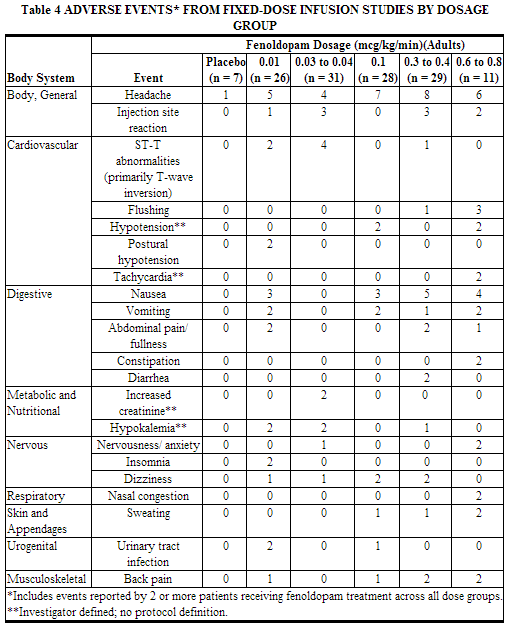
Adverse effects in overall data base
- The adverse event incidences listed below are based on observations of over 1,000 fenoldopam treated adult patients and not listed in the table above.
Events reported with a frequency between 0.5 to 5% in patients treated with IV fenoldopam: Cardiovascular: Extrasystoles, palpitations, bradycardia, heart failure, ischemic heart disease, myocardial infarction, angina pectoris. Metabolic: Elevated BUN, elevated serum glucose, elevated transaminase, elevated LDH. General Body: Non-specific chest pain, pyrexia. Hematologic/Lymphatic: Leukocytosis, bleeding. Respiratory: Dyspnea, upper respiratory disorder. Genitourinary: Oliguria. Musculoskeletal: Limb cramp.
Pediatric Patients
- In pediatric patients, the most common adverse events reported during short-term administration in controlled trials (30 minutes) were hypotension and tachycardia. However, because of the short exposure, there is limited experience with defining adverse events in children. The long-term effects of fenoldopam on growth and development have not been studied.
Postmarketing Experience
There is limited information regarding Postmarketing Experience of Fenoldopam in the drug label.
Drug Interactions
- Beta-Blockers: Concomitant use of fenoldopam with beta blockers should be avoided. If the drugs are used together, caution should be exercised because unexpected hypotension could result from beta blocker inhibition of the sympathetic reflex response to fenoldopam.
- There is limited experience with concomitant antihypertensive agents such as alpha blockers, calcium channel blockers, ACE inhibitors, and diuretics (both thiazide-like and loop).
- Intravenous fenoldopam has been administered safely with drugs such as digitalis and sublingual nitroglycerin.
Use in Specific Populations
Pregnancy
- Oral reproduction studies have been performed in rats and rabbits at doses of 12.5 to 200 mg/kg/day and 6.25 to 25 mg/kg/day, respectively. Studies have revealed maternal toxicity at the highest doses tested but no evidence of impaired fertility or harm to the fetus due to fenoldopam. However, there are no adequate and well-controlled studies in pregnant women. Since animal reproduction studies are not always predictive of human response, fenoldopam should be used in pregnancy only if clearly needed.
Pregnancy Category (AUS):
There is no Australian Drug Evaluation Committee (ADEC) guidance on usage of Fenoldopam in women who are pregnant.
Labor and Delivery
There is no FDA guidance on use of Fenoldopam during labor and delivery.
Nursing Mothers
Fenoldopam is excreted in milk in rats. It is not known whether this drug is excreted in human milk. Because many drugs are excreted in human milk, caution should be exercised when fenoldopam is administered to a nursing woman.
Pediatric Use
- Anti-hypertensive effects of fenoldopam have been studied in pediatric patients age < 1 month (at least 2 kg or full term) to 12 years old requiring blood pressure reduction.
- Clinical studies of fenoldopam did not include subjects ages 12 to 16 years of age to determine if they respond differently from younger subjects or adults. The pharmacokinetics of fenoldopam are independent of age when corrected for body weight. * Dose selection for patients 12 to 16 years of age should consider the patient's clinical condition and concomitant drug therapy.
Geriatic Use
- Clinical studies of fenoldopam did not include sufficient numbers of subjects aged 65 and over to determine whether they respond differently from younger subjects.
- Other reported clinical experience has not identified differences in responses between the elderly and younger patients. In general, dose selection for an elderly patient should be cautious, usually starting at the low end of the dosing range, reflecting the greater frequency of decreased hepatic, renal, or cardiac function, and of concomitant disease or other drug therapy.
Gender
There is no FDA guidance on the use of Fenoldopam with respect to specific gender populations.
Race
There is no FDA guidance on the use of Fenoldopam with respect to specific racial populations.
Renal Impairment
There is no FDA guidance on the use of Fenoldopam in patients with renal impairment.
Hepatic Impairment
There is no FDA guidance on the use of Fenoldopam in patients with hepatic impairment.
Females of Reproductive Potential and Males
There is no FDA guidance on the use of Fenoldopam in women of reproductive potentials and males.
Immunocompromised Patients
There is no FDA guidance one the use of Fenoldopam in patients who are immunocompromised.
Administration and Monitoring
Administration
Monitoring
Frequent blood pressure monitoring is recommended.
IV Compatibility
Fenoldopam is compatible with:
- 0.9% Sodium Chloride.
- 5% Dextrose.
Overdosage
- Intentional fenoldopam overdosage has not been reported. The most likely reaction would be excessive hypotension which should be treated with drug discontinuation and appropriate supportive measures.
Pharmacology
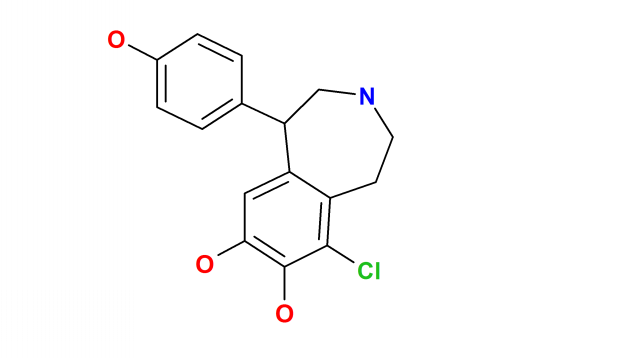
| |
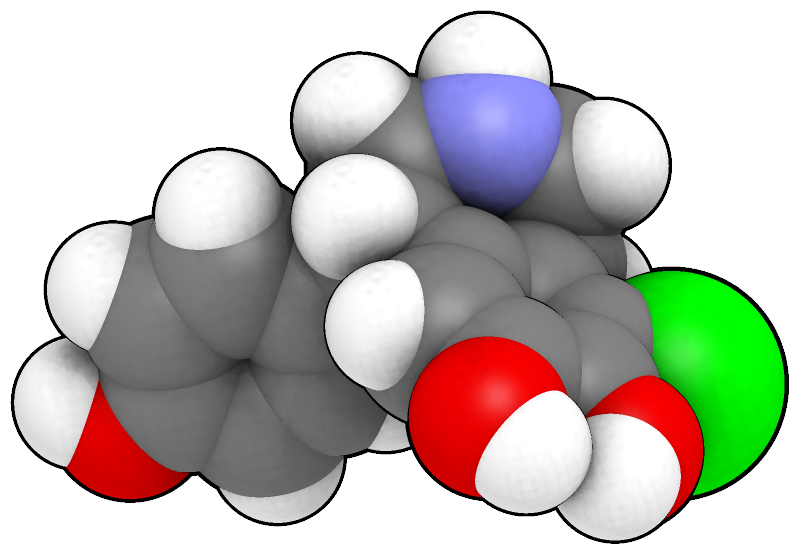
| |
1 : 1 mixture (racemate)Fenoldopam
| |
| Systematic (IUPAC) name | |
| (RS)-6-chloro-1-(4-hydroxyphenyl)-2,3,4,5-tetrahydro-1H-3-benzazepine-7,8-diol | |
| Identifiers | |
| CAS number | |
| ATC code | C01 |
| PubChem | |
| DrugBank | |
| Chemical data | |
| Formula | Template:OrganicBox atomTemplate:OrganicBox atomTemplate:OrganicBoxTemplate:OrganicBoxTemplate:OrganicBoxTemplate:OrganicBoxTemplate:OrganicBox atomTemplate:OrganicBoxTemplate:OrganicBoxTemplate:OrganicBoxTemplate:OrganicBoxTemplate:OrganicBoxTemplate:OrganicBoxTemplate:OrganicBox atomTemplate:OrganicBoxTemplate:OrganicBox atomTemplate:OrganicBoxTemplate:OrganicBoxTemplate:OrganicBoxTemplate:OrganicBoxTemplate:OrganicBoxTemplate:OrganicBoxTemplate:OrganicBox |
| Mol. mass | 305.76 g/mol |
| SMILES | & |
| Pharmacokinetic data | |
| Bioavailability | ? |
| Metabolism | Hepatic (CYP not involved) |
| Half life | 5 minutes |
| Excretion | Renal (90%) and fecal (10%) |
| Therapeutic considerations | |
| Pregnancy cat. |
B(US) |
| Legal status |
[[Prescription drug|Template:Unicode-only]](US) |
| Routes | IV |
Mechanism of Action
- Fenoldopam is a rapid-acting vasodilator. It is an agonist for D1-like dopamine receptors and binds with moderate affinity to α2-adrenoceptors. It has no significant affinity for D2-like receptors, α1 and β adrenoceptors, 5HT1 and 5HT2 receptors, or muscarinic receptors. Fenoldopam is a racemic mixture with the R-isomer responsible for the biological activity. The R-isomer has approximately 250-fold higher affinity for D1-like receptors than does the S-isomer. In non-clinical studies, fenoldopam had no agonist effect on presynaptic D2-like dopamine receptors, or α- or β-adrenoceptors, nor did it affect angiotensin-converting enzyme activity. Fenoldopam may increase norepinephrine plasma concentration.
Structure
- Corlopam (Fenoldopam Mesylate Injection, USP) is a dopamine D1-like receptor agonist. The product is formulated as a solution to be diluted for intravenous infusion. Chemically it is 6-chloro-2,3,4,5-tetrahydro-1-(4-hydroxyphenyl)-[1H]-3-benzazepine-7,8-diol methanesulfonate with the following structure:
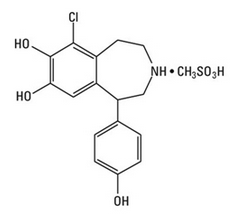
- Fenoldopam mesylate is a white to off-white powder with a molecular weight of 401.87 and a molecular formula of C16H16ClNO3•CH3SO3H. It is sparingly soluble in water, ethanol and methanol, and is soluble in propylene glycol.
- Ampules: Each 1 mL contains, in sterile aqueous solution, citric acid 3.44 mg; fenoldopam mesylate equivalent to fenoldopam 10 mg; propylene glycol 518 mg; sodium citrate dihydrate 0.61 mg; sodium metabisulfite 1 mg.
Pharmacodynamics
- In a randomized double-blind, placebo-controlled, 5-group study in 32 patients with mild to moderate essential hypertension (diastolic blood pressure between 95 and 119 mm Hg), and a mean baseline pressure of about 154/98 mm Hg, and heart rate of about 75 bpm, fixed-rate IV infusions of fenoldopam produced dose-related reductions in systolic blood pressures and diastolic blood pressures.
- In animals, fenoldopam has vasodilating effects in coronary, renal, mesenteric and peripheral arteries. All vascular beds, however, do not respond uniformly to fenoldopam. Vasodilating effects have been demonstrated in renal efferent and afferent arterioles.
Pharmacokinetics
- Adult Patients: Fenoldopam, administered as a constant infusion at dosages of 0.01 to 1.6 mcg/kg/min, produced steady-state plasma concentrations that were proportional to infusion rates. The elimination half-life was about 5 minutes in mild to moderate hypertensives, with little difference between the R (active) and S isomers. Steady state concentrations are attained in about 20 minutes (4 half-lives). * The steady state plasma concentrations of fenoldopam, at comparable infusion rates, were similar in normotensive patients and in patients with mild to moderate hypertension or hypertensive emergencies.
- The pharmacokinetics of fenoldopam were not influenced by age, gender, or race in adult patients with a hypertensive emergency. There have been no formal drug-drug interaction studies using intravenous fenoldopam. Clearance of parent (active) fenoldopam is not altered in adult patients with end-stage renal disease on continuous ambulatory peritoneal dialysis (CAPD) and is not altered in adult patients with severe hepatic failure. The effects of hemodialysis on the pharmacokinetics of fenoldopam have not been evaluated.
- Pediatric Patients: In children, aged 1 month to 12 years old, steady-state fenoldopam plasma concentrations were proportional to dose (0.05 mcg/kg/min to 3.2 mcg/kg/min). The elimination half-life and clearance were 3 to 5 minutes and 3 L/h/kg, respectively.
- In radiolabeled studies in rats, no more than 0.005% of fenoldopam crossed the blood-brain barrier.
Excretion and Metabolism
- Radiolabeled studies show that about 90% of infused fenoldopam is eliminated in urine, 10% in feces. Elimination is largely by conjugation, without participation of cytochrome P-450 enzymes. The principal routes of conjugation are methylation, glucuronidation, and sulfation. Only 4% of the administered dose is excreted unchanged. Animal data indicate that the metabolites are inactive.
Nonclinical Toxicology
- In a 24-month study, mice treated orally with fenoldopam at 12.5, 25, or 50 mg/kg/day, reduced to 25 mg/kg/day on day 209 of study, showed no increase above controls in the incidence of neoplasms. Female mice in the highest dose group had an increased incidence and degree of severity of a fibro-osseous lesion of the sternum compared with control or low-dose animals. Compared to controls, female mice in the middle- and upper-dose groups had a higher incidence and degree of severity of chronic nephritis. These pathologic lesions were not seen in male mice treated with fenoldopam.
- In a 24-month study, rats treated orally with fenoldopam at 5, 10 or 20 mg/kg/day, with the mid- and high-dose groups increased to 15 or 25 mg/kg/day, respectively, on day 372 of the study, showed no increase above controls in the incidence or type of neoplasms. Compared with the controls, rats in the mid- and high-dose groups had a higher incidence of hyperplasia of collecting duct epithelium at the tip of the renal papilla.
- Fenoldopam did not induce bacterial gene mutation in the Ames test or mammalian gene mutation in the Chinese hamster ovary (CHO) cell assay. In the in vitro chromosomal aberration assay with CHO cells, fenoldopam was associated with statistically significant and dose-dependent increases in chromosomal aberrations, and in the proportion of aberrant metaphases. However, no chromosomal damage was seen in the in vivo mice micronucleus or bone marrow assays.
- Oral fertility and general reproduction performance studies in male and female rats at 12.5, 37.5 or 75 mg/kg/day revealed no impairment of fertility or reproduction performance due to fenoldopam.
Animal Toxicology
- Unusual toxicologic findings (arterial lesions in the rat) with fenoldopam are summarized below. These findings have not been observed in mice or dogs. No evidence of a similar lesion in humans has been observed.
- Arterial lesions characterized by medial necrosis and hemorrhage have been seen in renal and splanchnic arteries of rats given fenoldopam mesylate by continuous intravenous infusion at doses of 1 to 100 mcg/kg/min for 24 hours. The incidence of these lesions is dose related. Arterial lesions morphologically identical to those observed with fenoldopam have been reported in rats infused with dopamine. Data suggest that the mechanism for this injury involves activation of D1-like dopaminergic receptors. Such lesions have not been seen in dogs given doses up to 100 mcg/kg/min by continuous intravenous infusion for 24 hours, nor were they seen in dogs infused at the same dose for 6 hours daily for 24 days. The clinical significance of this finding is not known.
- Oral administration of fenoldopam doses of 10 to 15 mg/kg/day or 20 to 25 mg/kg/day to rats for 24 months induced a higher incidence of polyarteritis nodosa compared to controls. Such lesions were not seen in rats given 5 mg/kg/day of fenoldopam or in mice given the drug at doses up to 50 mg/kg/day for 24 months.
Clinical Studies
Adult Patients
- In a randomized double-blind, placebo-controlled, 5-group study in 32 patients with mild to moderate essential hypertension (diastolic blood pressure between 95 and 119 mm Hg), and a mean baseline pressure of about 154/98 mm Hg, and heart rate of about 75 bpm, fixed-rate IV infusions of fenoldopam produced dose-related reductions in systolic and diastolic blood pressures. Infusions were maintained at a fixed rate for 48 hours. The table below shows the results of the study. The onset of response was rapid at all infusion rates, with the 15-minute response representing 50 to 100% of the 1 hour response in all groups. There was some suggestion of partial tolerance at 48 hours in the 2 higher dose infusions, but a substantial effect persisted through 48 hours. When infusions were stopped, blood pressure gradually returned to pretreatment values with no evidence of rebound.
- This study suggests that there is no greater response to 0.8 mcg/kg/min than to 0.4 mcg/kg/min.
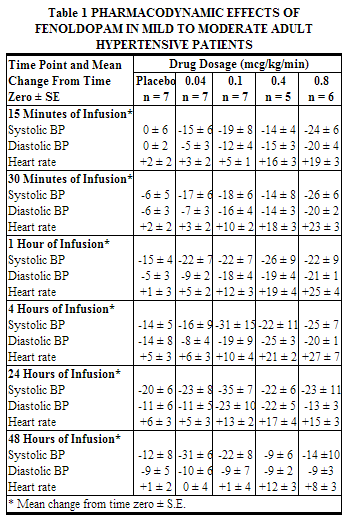
- In a multicenter, randomized, double-blind comparison of four infusion rates, fenoldopam was administered as constant rate infusions of 0.01, 0.03, 0.1 and 0.3 mcg/kg/min for up to 24 hours to 94 adult patients experiencing hypertensive emergencies (defined as diastolic blood pressure ≥ 120 mm Hg with evidence of compromise of end-organ function involving the cardiovascular, renal, cerebral or retinal systems). Infusion rates could be doubled after one hour if clinically indicated. There were dose-related, rapid-onset, decreases in systolic and diastolic blood pressures and increases in heart rate.

- Two hundred thirty-six (236) severely hypertensive adult patients (DBP ≥ 120 mm Hg), with or without end-organ compromise, were randomized to receive in 2 open-label studies either fenoldopam or nitroprusside. The response rate was 79% (92/117) in the fenoldopam group and 77% (90/119) in the nitroprusside group. Response required a decline in supine diastolic blood pressure to less than 110 mm Hg if the baseline were between 120 and 150 mm Hg, inclusive, or by ≥ 40 mm Hg if the baseline were ≥ 150 mm Hg. Patients were titrated to the desired effect. For fenoldopam, the dose ranged from 0.1 to 1.5 mcg/kg/min; for nitroprusside, the dose ranged from 1 to 8 mcg/kg/min. As in the study in mild to moderate hypertensives, most of the effect seen at 1 hour is present at 15 minutes. The additional effect seen after 1 hour occurs in all groups and may not be drug-related (there was no placebo group for evaluation).
Pediatric Patients
- In a randomized, multi-center, double-blind, placebo-controlled, dose-ranging study, pediatric patients were randomized in equal proportions to 1 of 5 treatment groups: 0.05, 0.2, 0.8, or 3.2 mcg/kg/min fenoldopam or placebo. Fenoldopam or placebo was administered as a blinded continuous IV infusion for 30 minutes. Following this, open-label titration of fenoldopam was given to induce hypotension or normotension (defined as mean arterial pressure, MAP, between 50 and 80 mmHg for patients > 1 month of age and MAP between 40 and 70 mmHg for patients ≤ 1 month). Seventy-seven pediatric patients (up to 12 years of age – Tanner Stages 1 and 2) were treated for at least two hours. Of these, 2 were < 1 month of age, 25 were between 1 month of age and 1 year of age, 7 were between 1 and 2 years of age, and 43 were between 2 and 12 years of age. Of the 77 patients enrolled in the trial, 58 were enrolled in association with surgery, and 19 were treated in an ICU setting.
- The lowest dosage at which decreases in MAP were seen during blinded administration was 0.2 mcg/kg/min. The dose at which the maximum effect was seen was 0.8 mcg/kg/min. * Doses higher than 0.8 mcg/kg/min generally produced no further decreases in MAP but did worsen tachycardia (Table 3). Changes in blood pressure and heart rate occurred as early as 5 minutes after starting infusion. Doses as high as 4 mcg/kg/min were administered during the open-label period. The effects increased with time for 15 to 25 minutes, and an effect could still be detected after an average of 4 hours of infusion. When the infusion was discontinued, blood pressure and heart rates approached baseline values during the following 30 minutes.
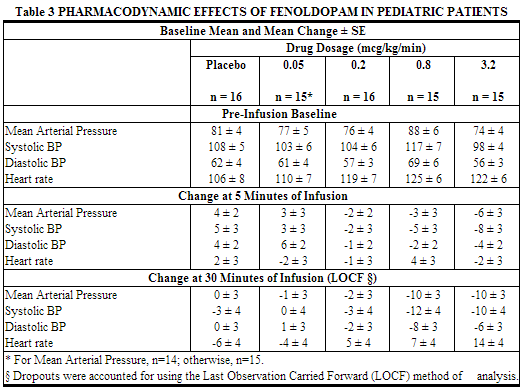
How Supplied
- Single-dose ampule: 10 mg/mL, 1 mL (one per carton).
- Single-dose ampule: 10 mg/mL, 2 mL (one per carton).
Storage
- Store at 2 to 30°C (35.6 to 86°F).
Images
Drug Images
{{#ask: Page Name::Fenoldopam |?Pill Name |?Drug Name |?Pill Ingred |?Pill Imprint |?Pill Dosage |?Pill Color |?Pill Shape |?Pill Size (mm) |?Pill Scoring |?NDC |?Drug Author |format=template |template=DrugPageImages |mainlabel=- |sort=Pill Name }}
Package and Label Display Panel
{{#ask: Label Page::Fenoldopam |?Label Name |format=template |template=DrugLabelImages |mainlabel=- |sort=Label Page }}
Patient Counseling Information
There is limited information regarding Patient Counseling Information of Fenoldopam in the drug label.
Precautions with Alcohol
- Alcohol-Fenoldopam interaction has not been established. Talk to your doctor about the effects of taking alcohol with this medication.
Brand Names
- CORLOPAM®[3]
Look-Alike Drug Names
There is limited information regarding Fenoldopam Look-Alike Drug Names in the drug label.
Drug Shortage Status
Price
References
The contents of this FDA label are provided by the National Library of Medicine.
- ↑ Landoni G, Biondi-Zoccai GG, Marino G, Bove T, Fochi O, Maj G; et al. (2008). "Fenoldopam reduces the need for renal replacement therapy and in-hospital death in cardiovascular surgery: a meta-analysis". J Cardiothorac Vasc Anesth. 22 (1): 27–33. doi:10.1053/j.jvca.2007.07.015. PMID 18249327.
- ↑ Garwood S, Swamidoss CP, Davis EA, Samson L, Hines RL (2003). "A case series of low-dose fenoldopam in seventy cardiac surgical patients at increased risk of renal dysfunction". J Cardiothorac Vasc Anesth. 17 (1): 17–21. doi:10.1053/jcan.2003.5. PMID 12635055.
- ↑ "CORLOPAM- fenoldopam mesylate injection, solution".
{{#subobject:
|Label Page=Fenoldopam |Label Name=FenoldopamPackage.png
}}